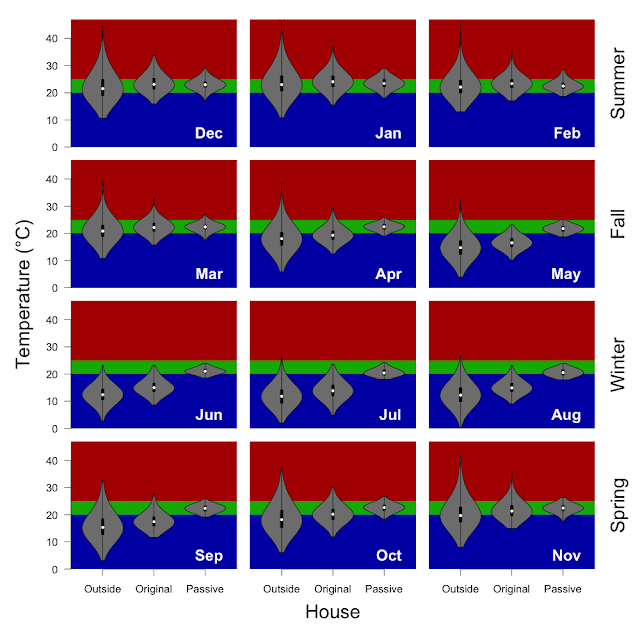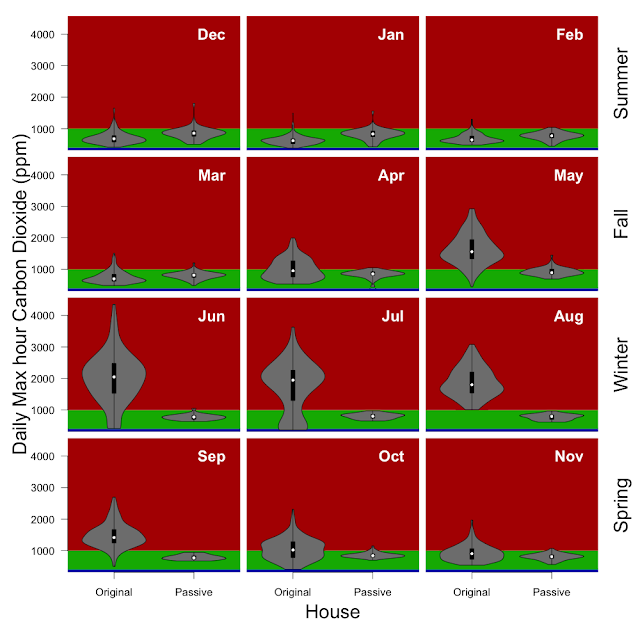H/ERV in the Sydney climate...
I should preface this post by saying that I am not the kind of person who likes to wear a jumper in the house during the middle of summer or shorts inside the house during the middle of winter. I get that the Passivhaus standard is all about specific temperature (20 - 25 °C) and specific humidity levels (not measured as relative humidity), but to me 18 °C feels great when you walk in from 8 °C and 27 °C is blessedly cool when it is 40 °C outside. By which I mean to say that as a biologist I undertand that the we experience things relative to our frame of reference, but I also like data.
So over the past 12 months we have had a few bits and pieces on loan from Zehnder and FanTech to see if ERV or HRV are better in the Sydney climate. I've learned alot in the process... and as I understand it none of this is commercial in confidence - quite to the contrary they are pleased for people to know about how their products work in Sydney. Spoiler: It works really well and I would absolutely recommend their system.
Disclaimer: I am not an engineer, but I am sharing my perspetive / understanding...
HRV or Heat Recovery Ventilation (often with an 'm' down the front because it is mechanical ventilation) is fairly simple in principle... In the winter the cold air being brought in from outside to provide fresh air is warmed by the warmer stale air it replaces. In the summer the warm air being brought in from outside to provide fresh air is cooled by the cooler stale are it replaces. Laws of physics (thermodynamics) dictate that you cannot get perfect heat exchange, but you can keep more than 95% of the heat inside during the winter. In the summer they don't quite keep as much heat out but you can keep ~ 90% of the cool in. (as I understand this is mainly about where the heat from the fans ends up and given that these systems were originally mostly about keeping heat in it made sense that heat lost from fans should end up inside rather than outside).
ERV or Enthalpy Recovery Ventilation is slightly more complex. In an HRV you will eventually end up with a situation where warm moist air hits cold dry air leading to condensation. In an HRV this isn't a problem (the unit has a drain for this purpose), but you can end up in the situation where your humidity is outside the desired range (especially in winter when the cold outside air is dry and it would be great if that moisture wasn't going down the drain [literally]). That is what ERV does: it allows moisture to be transfered between the incoming and outgoing air with a goal of maintaining nice humidity in your house. But the desireability of humidity exchange is climate specific.
The Sydney climate is a bit inbetween so it wasn't clear based on first principles if ERV was worth it. Slight digression: EVR costs a bit more than HRV (but not enough to really care about), but more importantly it is slightly less efficient. So while HRV is keeping >95% of the heat in, ERV is "only" keeping about 90% of the heat in. While HRV is keeping ~ 90% of the cool in, the ERV is "only" keeping 85% of the cool in. Of course the system is smart enough to check the inside and outside air temperature to determine if heat recovery is a good thing to do... I tell the system what temperature I want, so if it is closer to my target outside than inside then no heat recovery = bypass the core. If the temperature inside is closer to the temperature I want then heat recovery = air travels through the core. (Yeah, it is a little more complex than that, but surprisingly not by much.)
So every ~ 8 weeks I've been swapping an ERV core and a HRV core... and we've had a computer hooked up to the Zehnder ComfoAir Q350 that logs everything the system is doing as well as the air temperature and humidity every 5 minutes. One of the super cool things about the Q350 is that the cores swap (yeah, a torx screw driver is all you need [and to carefully follow the service manual instructions {don't try it on yours unless you are really sure you know what you're doing / these are not instructions on how to replace your core / doing this could void your warrantee / I am not responsible if you break your unit}] to swap the cores over). Asside from swapping the cores you just tell the machine's software it has a different core and you have a HRV instead of an ERV or vice versa. So periodically I send them a datafile (about 700kb a week).
What did we/they find? In essence it boils down to: they both work, but HRV has got your back and ERV isn't worth the costs. That is mainly due to the fact that Sydney has great weather... and because the system is bypassing heat recovery almost every night during the summer (and we often open the windows on summer evenings when the temperature drops to flush cool air through the house). As a result you don't get much benefit from the humidity moderation. In the winter when the bypass is rarely activated the temperature / humidity is good and the humidity moderation isn't that important (the air just isn't that cold and dry). While we were comfortable in the house during the winter, having the house a little bit drier would actually be closer to the Passive House spec.
So while ERV works great when winter leads to inside air that is too dry or when summer leads to inside air that is too moist... Sydney is apparenly close enough to just right such that we are better off with the higher efficiency of the HRV core. For the same reason that we've been swapping cores for the last 12 months - the choice of cores is climate specific.
On a side note: The HRV system only works if the air going in and out of your house is going through the unit. This is one of the reasons why air tightness is a key passive house principle. It isn't that impressive to say that you can keep a building at a specified temperature - the key is to maintain temperature efficiently. Mechanical HRV is a key part of maintaining a comfortable temperature in our house while only using ~ 0.8kWh a day (in 2020: 283kWh / 338days). Sure we occasionally also use a 5kW split system to heat or cool when needed, but a well-designed and well-built house makes it much easier and cheaper to stay comfortable. At least for the winter months, we use an extra 0.5kWh of energy a day for every degree below 20 °C.
Zehnder and FanTech provided access to an ERV core and the vector bus to USB adaptor for the last 12 months, but they are not responsible for any of the content of this post.


